India Makhana (Fox Nut) Market Outlook to 2030
By Market Structure, By Product Type, By Size/Grade, By Distribution Channel, By Application, and By Region
- Product Code: TDR0244
- Region: Asia
- Published on: August 2025
- Total Pages: 110
Introducing the World's FirstPay-Per-Section Market Reports
Why pay for the full report when you need just a part?
Start Building Your Report
Scroll down to see available sections
Report Summary
The report titled “India Makhana Market Outlook to 2030 – By Market Structure, By Product Type, By Size/Grade, By Distribution Channel, By Application, and By Region” provides a comprehensive analysis of India’s makhana industry. The report covers the overview and genesis of the sector, overall market size in terms of revenue, and granular segmentation; trends and developments, the regulatory landscape, customer-level profiling, issues and challenges, and a competitive landscape including competition scenario, cross-comparison, opportunities and bottlenecks, and detailed company profiles of major brands and processor-exporters. The report concludes with future market projections based on production tonnage and conversion yields, product mix and certifications, regional sourcing/processing hubs, cause-and-effect relationships across the value chain, and success case studies highlighting key opportunities
India Makhana Market Overview and Size
The India Makhana market is valued at INR 100 billion, underpinned by strong five‑year value growth. This expansion is powered by surging domestic consumption, escalating interest in healthy snacking, and expanding export demand—supported by rising awareness of makhana’s nutrition and versatility.
Major cultivation and processing hubs in Bihar—particularly Patna, Darbhanga, and Muzaffarpur—dominate this market, owing to ideal agro‑climatic conditions, extensive water bodies for pond cultivation, longstanding local processing expertise, and targeted government incentives for makhana farming.
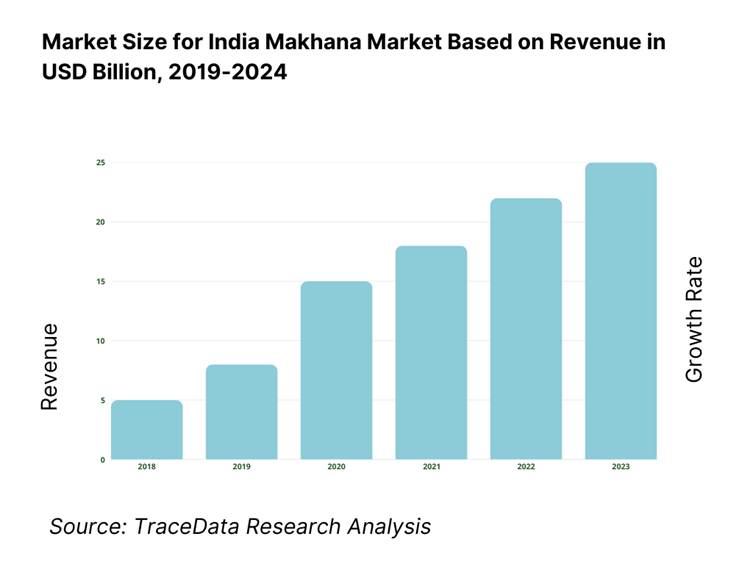
What Factors are Leading to the Growth of the India Makhana Market:
Strong Agricultural Foundation: Agriculture, forestry, and fishing contributed 15.57 percent to India's GDP in 2023, equivalent to approximately USD 567 billion in agricultural output, underscoring the strength of the primary sector that supports makhana cultivation and supply‑chain stability. The agricultural sector remains a key macroeconomic pillar, supplying raw makhana and ensuring resilience through input availability. This strong base underlines why makhana processing and production continue to attract investment and expansion.
Robust Economic Growth Fueling Demand: India’s GDP in 2024 was estimated at approximately USD 3.91 trillion, with annual economic growth around 6.5 percent. This growth has uplifted disposable incomes, particularly across urban centers, boosting consumer spending on premium, healthy snacks like makhana. The macroeconomic upswing indicates increasing purchasing power and market potential for value-added products within the makhana industry.
Controlled Food Inflation Enhancing Affordability: In mid-2025, India's consumer price inflation fell sharply to around 2.10 percent, with food prices—including vegetables and pulses—declining significantly. While deflation in certain food categories squeezes farm margins, the overall reduction in food price inflation enhances affordability of makhana for price-sensitive consumers and expands its market reach.
Which Industry Challenges Have Impacted the Growth of the India Makhana Market:
High Post-Harvest Losses Due to Infrastructure Gaps: Approximately 30 percent of India’s agricultural output is lost post-harvest because of inadequate storage, cold chain, and transport infrastructure. For perishable or semi-processed products like makhana (especially raw seeds and popped kernels), this loss significantly raises costs and undermines supply reliability in the value chain.
Inflation Pressures on Input Costs Despite Overall Price Stability: While general food inflation is low, wholesale food prices turned negative around –0.13 percent in mid‑2025, led by sharp drops in vegetable prices. For makhana producers, this trend compresses margins, since labor, fuel, and utility costs—driven by broader inflation—continue rising even as output prices decline.
Declining Agricultural Workforce Share Amid Rising Urbanization: Although agriculture still contributed around 17.6 percent to GDP in 2024, its employment share is shrinking as urban and service sectors expand. This structural shift threatens the availability of rural labor for labor‑intensive makhana activities like harvesting and popping, potentially raising wages and disrupting production cycles.
What are the Regulations and Initiatives which have Governed the Market:
FSSAI Standards & Licensing Requirements: Makhana products must comply with FSSAI regulations for processed food safety, labeling, and health claims. Licenses are mandated for manufacturing, packaging, and selling. Compliance ensures that nutritional content, ingredient lists, and allergen disclaimers meet national standards, enabling market access across retail and e‑commerce channels. Currently, FSSAI oversees this licensing framework.
Agmark & DMI Draft Trading Standards for Seeds and Processed Makhana: The Directorate of Marketing & Inspection (under Ministry of Agriculture) has issued draft tradeable parameters for both popped makhana and seed makhana. These parameters specify allowable limits for moisture, foreign matter, grading by size (mm), and cleanliness—establishing standardized specifications to improve quality control across the supply chain and facilitate fair trade.
Geographical Indication (GI) Registration – Mithila Makhana: The GI registry has granted a GI tag for “Mithila Makhana,” which confers legal protection and branding rights over makhana produced in that geographic region (within Bihar). Only authorized producers can label their makhana as Mithila Makhana. This policy supports premium positioning and marketing, while regulating usage and preventing misuse of the GI tag.
India Makhana Market Segmentation
By Product Type: India’s makhana market is divided into raw makhana, roasted makhana, flavored makhana, and makhana powder. Roasted makhana commands the largest share, primarily driven by its ready-to-eat convenience and alignment with health-conscious consumer preferences. The proliferation of convenient snacking formats and strong branding by players focusing on roasted variants reinforce its leading position.
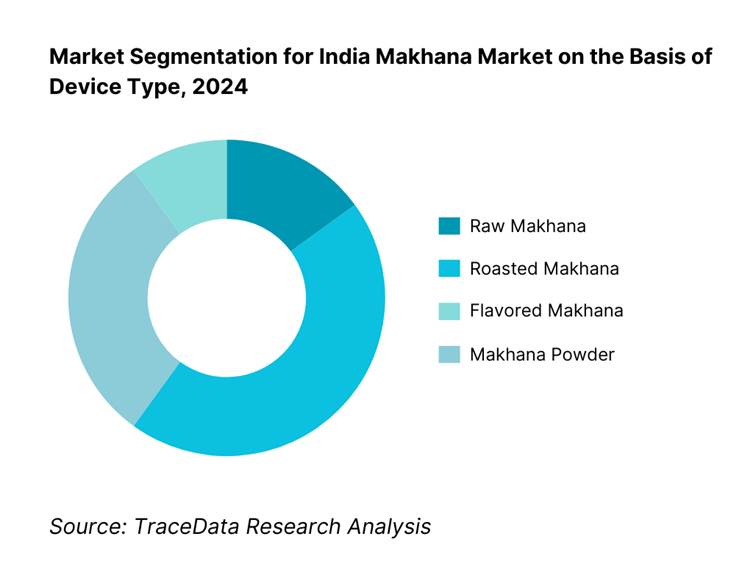
By Distribution Channel: India's makhana market is segmented among supermarkets/hypermarkets, convenience/specialty stores, and online retail. Online retail leads, reflecting rising internet penetration, consumers’ preference for home delivery, and ease of accessing niche variants like flavored or GI-tagged makhana.
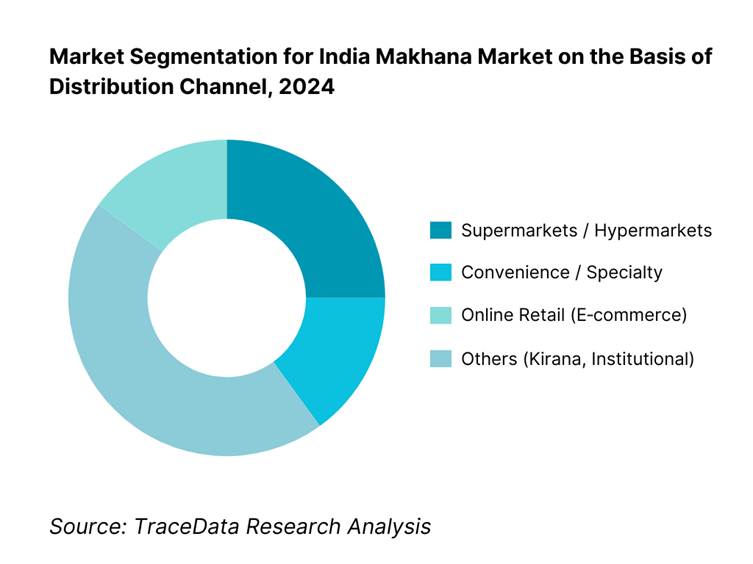
Competitive Landscape in India Makhana Market
The India Makhana market features notable players with diverse offerings. A preliminary snapshot of the competitive terrain is captured below. The India Makhana market features a concentrated pool of major brands—Bagrry’s, Farmley, Sattviko, Too Yumm, Mr. Makhana—and regional processors, indicating consolidation with differentiation via branding, flavor innovation, and certification-driven positioning.
Name | Founding Year | Original Headquarters |
Tata Sampann | 2015 | Mumbai, India |
Haldiram’s (Magic Makhana) | 1937 | Bikaner, India |
Patanjali Ayurved | 2006 | Haridwar, India |
Farmley | 2017 | New Delhi, India |
Happilo | 2016 | Bengaluru, India |
Mr. Makhana | 2014 | Noida, India |
Sattviko | 2014 | Jaipur, India |
Urban Platter | 2015 | Mumbai, India |
Nutty Yogi | 2016 | Bengaluru, India |
Open Secret | 2019 | Mumbai, India |
Too Yumm (Guiltfree Industries) | 2017 | Kolkata, India |
Some of the Recent Competitor Trends and Key Information About Competitors Include:
Tata Sampann: As one of the leading FMCG entrants in the makhana space, Tata Sampann strengthened its presence in modern trade in 2024 by introducing new flavored variants such as peri-peri and pudina, supported by aggressive nationwide marketing campaigns and retail tie-ups.
Farmley: Known for its premium positioning, Farmley expanded its e-commerce and D2C footprint in 2024 by launching QR-code traceability for its makhana packs, ensuring transparency in sourcing. It also rolled out organic and jumbo-grade makhana lines to cater to the rising demand for healthy snacking.
Haldiram’s (Magic Makhana): A dominant legacy snack brand, Haldiram’s leveraged its extensive distribution network in 2024 by launching festive gift packs of makhana alongside its traditional sweets, capitalizing on seasonal demand and strong consumer trust in its brand name.
Mr. Makhana: As a pioneer in flavored makhana, Mr. Makhana continued its international expansion in 2024 by securing retail placements in the UK and Middle East. The brand also introduced innovative flavors like cheese and herbs to attract younger demographics seeking novel snacking options.
Sattviko: With a focus on health and ayurvedic positioning, Sattviko broadened its reach in 2024 through tie-ups with major online grocery platforms and introduced smaller trial packs targeted at gym-goers and fitness enthusiasts, boosting its visibility in the wellness segment.
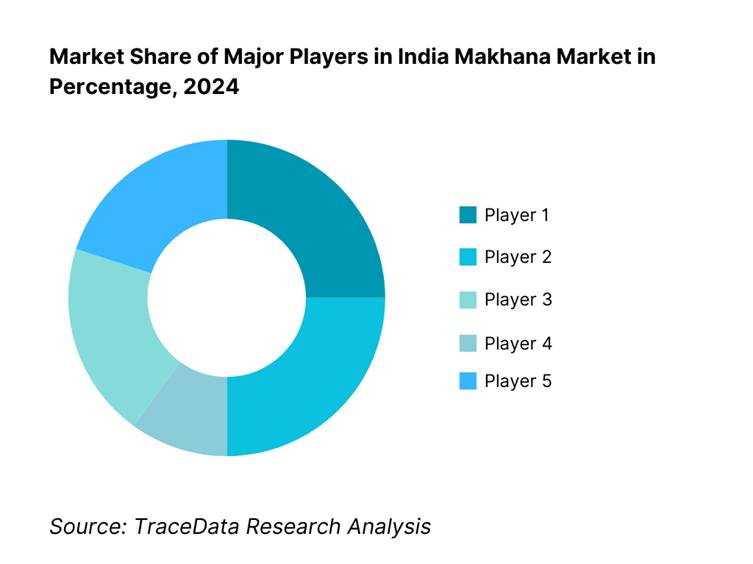
What Lies Ahead for India Makhana Market?
The India makhana market is expected to witness consistent growth in the coming years, supported by rising consumer preference for healthy snacking, expansion of organized retail and e-commerce channels, and government initiatives to promote cultivation and exports. Growing awareness about nutritional benefits, coupled with GI-tag recognition for Mithila Makhana, is set to further strengthen the market’s premium positioning.
Rise of Value-Added Products: The future of the India makhana market will be shaped by innovations in product offerings, such as flavored, roasted, and ready-to-cook variants. The development of makhana flour, protein bars, and confectionery applications will expand consumption beyond traditional snacking, increasing its presence across FMCG categories.
Expansion of Organized & Online Distribution: Organized retail and online platforms will play a critical role in widening consumer access. E-commerce, quick commerce, and subscription models are expected to accelerate product penetration in urban markets while modern trade will help in building nationwide visibility for branded makhana.
Focus on Quality & Certification: With consumers increasingly valuing authenticity and safety, certifications such as Organic, GI-tag, and FSSAI compliance will become vital. Brands emphasizing traceability, QR-coded sourcing, and premium grade (jumbo or king-size) offerings will differentiate themselves in the competitive landscape.
Export Potential & Global Reach: The GI recognition of Mithila Makhana and support from agencies like APEDA will open new export corridors to Europe, North America, and the Middle East. Growing demand for plant-based and gluten-free snacks globally positions Indian makhana as a strong contender in the international healthy snacking segment.
Leveraging Technology in Processing: Mechanization in roasting, polishing, and grading will become central to improving yield, quality consistency, and scalability. Technology integration will not only reduce wastage but also enable processors to meet rising domestic and export demand effectively.
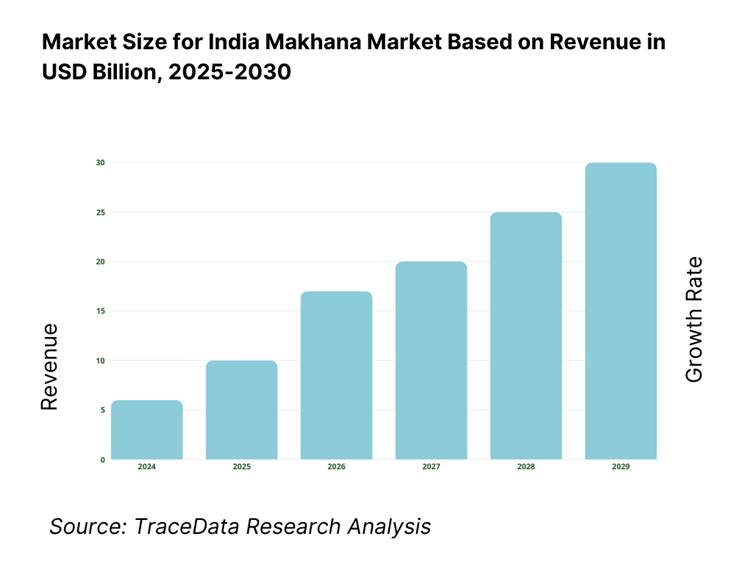
India Makhana Market Segmentation
By Product Type
Raw Makhana
Roasted Makhana
Flavored Makhana
Makhana Flour / Powder
Ready-to-Eat / Ready-to-Cook Mixes
By Size / Grade
Small
Medium
Large
Jumbo (King / 5-Star)
Mixed Grade
By Distribution Channel
General Trade (Kirana Stores)
Modern Trade (Supermarkets & Hypermarkets)
Online / E-Commerce
Quick Commerce Platforms
HORECA / Institutional Sales
By Application
Snacking
Fasting / Religious Use
Culinary / Cooking Ingredient
Bakery & Confectionery
Dietary / Ayurvedic Use
By Packaging Type
Pouches
Jars
Cans / Tins
Sachets / Small Trial Packs
Bulk Packaging
Players Mentioned in the Report:
Tata Sampann
Haldiram’s Magic Makhana
Patanjali
Farmley
Happilo
Mr. Makhana
Sattviko
Urban Platter
Nutty Yogi
Open Secret
Too Yumm (Guiltfree)
Madhubani Makhana (Processor)
Maruti Makhana / Natura Foods
National Makhana Udyog
Koshi Flavours
Key Target Audience
Makhana brand managers
Food processors & agritech investors
Retail and e-commerce category leads
Export promotion agencies (APEDA)
Organic & GI certification bodies (GI Registry)
Regional agricultural departments (e.g., Bihar Agriculture Dept.)
Investments and venture capitalist firms
Government and regulatory bodies
Time Period:
Historical Period: 2019-2024
Base Year: 2025
- Forecast Period: 2025-2030
Report Coverage
Choose individual sections to purchase. Mix and match as you like.
- -
- -
4. Value Chain Analysis for India Makhana Market
4.1 Cultivation to Processing Flow (pond-to-popped kernels)-Costs, Margins, Challenges
4.2 Revenue Streams [raw seeds, popped kernels, roasted & flavored makhana, makhana flour/powder, exports]
4.3 Business Model Canvas for India Makhana Industry [procurement model, processing, branding, distribution, revenue streams, cost structure, key partners]
$1005.1 Unorganized vs Organized Players [share of mandis, SMEs, and branded FMCG]
5.2 Investment Models in India Makhana Market [contract farming, pond leasing, mechanized popping units, flavoring/packaging lines]
5.3 Comparative Analysis of Sourcing & Processing between Private Brands and Government/FPO Initiatives
5.4 Budget Allocation by Brands for Marketing, Processing Automation, and Certification
$150- $100
- $200
8.1 Revenues
$3009.1 By Market Structure (Unorganized vs Organized/Branded)
9.2 By Product Type (Raw Seeds, Popped Kernels, Roasted-Flavored, Flour/Powder, RTE/RTC Mixes)
9.3 By Grade/Size (Small, Medium, Large, Jumbo-œKing/5-Star-, Mixed Grade)
9.4 By Distribution Channel (General Trade, Modern Trade, E-Commerce/D2C, Quick Commerce, HORECA/Institutional)
9.5 By Application (Snacking, Fasting/Religious Use, Culinary/Ingredient, Bakery, Dietary/Ayurvedic Use)
9.6 By Certification/Origin (Conventional, Organic, GI-Tagged Mithila Makhana, Private-Label)
9.7 By Region (North, East-Bihar/Jharkhand/UP, West, South, North-East)
$40010.1 Consumer Cohort Analysis (urban health seekers, fasting/ritual users, kids & youth, gym/fitness groups, HORECA buyers)
10.2 Decision-Making Process in Choosing Makhana Brands (price vs grade vs certification vs flavor)
10.3 Product Effectiveness and Consumer ROI (perceived health benefits, repeat purchase frequency)
10.4 Gap Analysis Framework (unmet demand in flavors, formats, geographies)
$50011.1 Trends & Developments in India Makhana Market [premiumization, flavored innovation, GI marketing, export destinations]
11.2 Growth Drivers [healthy snacking boom, ayurvedic/ritual use, export push, retail penetration]
11.3 SWOT Analysis for India Makhana Market
11.4 Issues & Challenges [seasonality, fragmented procurement, breakage %, lack of mechanization, price volatility]
11.5 Government Regulations [FSSAI standards, Agmark draft grading norms, APEDA export guidelines, GI registry enforcement]
$20012.1 Market Size & Future Potential for Online/D2C Makhana Sales
12.2 Business Model and Revenue Streams [subscription packs, gifting bundles, single-serve sachets]
12.3 Delivery Models & Product Types Offered [flavored, organic, GI-tagged, festival SKUs]
12.4 Cross-Comparison of Leading Online Makhana Companies (Farmley, Mr. Makhana, Sattviko, Urban Platter, Nutty Yogi, Open Secret) based on Company Overview, Investment & Funding, Revenues, Number of SKUs, Price Points, Certification, Channel Presence
$500- $250
- $150
15.1 Market Share of Key Players (basis revenues, SKUs, distribution reach)
15.2 Benchmarking of 15 Competitors
15.3 Operating Model Analysis Framework
15.4 Gartner Magic Quadrant (positioning of branded FMCG vs niche startups vs processors)
15.5 Bowmans Strategic Clock for Competitive Advantage
$75016.1 Revenues, 2025-2030
$30017.1 By Market Structure
17.2 By Product Type
17.3 By Grade/Size
17.4 By Distribution Channel
17.5 By Application
17.6 By Certification/Origin
17.7 By Region
$400- $250
- $250
Research Methodology
Step 1: Ecosystem Creation
We begin by mapping the ecosystem of the India Makhana Market to capture both demand-side and supply-side entities. On the supply side, this includes pond owners, seed collectors (dholia workers), processors (drying, roasting, polishing, grading units), wholesalers, regional traders, and branded players. On the demand side, it covers modern retail chains, e-commerce platforms, kirana stores, quick-commerce operators, HORECA buyers, and export agencies. Based on this mapping, we shortlist 5–6 leading makhana brands and processors—such as Tata Sampann, Farmley, Haldiram’s, Mr. Makhana, and Sattviko—using criteria including distribution breadth, export presence, certifications, and financial information. Data sourcing is conducted via agricultural ministry reports, GI registry documentation, industry articles, APEDA export updates, and proprietary secondary databases.
Step 2: Desk Research
In the second phase, we perform extensive desk research across diverse secondary and proprietary databases to compile industry-level insights. This includes studying statistics on pond acreage, seed-to-pop conversion ratios, and GI-tagged production volumes from Bihar and neighboring states. We analyze processing costs, trade flows, and channel-wise sales contributions. Company-level insights are gathered from press releases, financial disclosures of listed FMCG players, annual reports of large food companies, and brand announcements on e-commerce platforms. This phase builds a foundational view of market revenues, number of organized versus unorganized processors, export corridors, and distribution footprints, ensuring a holistic understanding of the market landscape.
Step 3: Primary Research
We then conduct in-depth interviews with stakeholders across the makhana value chain, including C-level executives of branded companies, heads of cooperatives/FPOs, APEDA officials, and large retail buyers. These interviews validate market hypotheses, confirm statistical findings, and provide ground-level insights on pricing ladders, margins, and operational challenges. A bottom-up approach is applied, starting with pond-level seed output, moving through processor conversion rates, and aggregating to brand-level sales. To ensure accuracy, our team employs disguised client interviews with processors and traders, enabling cross-validation of operational and financial information against secondary sources. These interactions provide clarity on revenue streams, value chains, seasonality, and certification practices.
Step 4: Sanity Check
Finally, we execute both bottom-up and top-down triangulation exercises to confirm the accuracy of our findings. Bottom-up aggregation from pond production volumes and processor yields is compared with top-down validation using retail off-take and export data from APEDA and government trade portals. This dual-check approach ensures internal consistency of the market model, offering a robust and verified view of the India Makhana Market size, segmentation, and future outlook.
FAQs
01 What is the potential for the India Makhana Market?
The India Makhana Market is poised for substantial expansion, reaching a valuation of INR 100 billion in 2024. This growth is driven by increasing consumer demand for healthy and protein-rich snacks, the expanding e-commerce ecosystem, and the recognition of Mithila Makhana under the Geographical Indication (GI) tag. The market’s potential is further supported by government encouragement of makhana farming in Bihar and neighboring states, alongside the rising adoption of value-added products such as flavored and roasted variants across urban India.
02 Who are the Key Players in the India Makhana Market?
The India Makhana Market features several key players, including Tata Sampann, Haldiram’s, Patanjali, Farmley, Happilo, and Mr. Makhana. These companies dominate due to their robust distribution networks, innovative flavored portfolios, and strong brand recall among consumers. Other notable players include Sattviko, Urban Platter, Nutty Yogi, Open Secret, Too Yumm, Madhubani Makhana, Maruti Makhana/Natura Foods, National Makhana Udyog, and Koshi Flavours, each carving a niche through certifications, organic positioning, or regional sourcing capabilities.
03 What are the Growth Drivers for the India Makhana Market?
The primary growth drivers include macroeconomic factors such as India’s USD 3.9 trillion GDP in 2024 (World Bank), which enhances consumer spending on premium healthy snacks. Rising health awareness and the demand for high-protein, gluten-free, and low-fat foods further propel adoption. The GI-tagging of Mithila Makhana strengthens consumer trust and provides export opportunities, while government schemes under the Ministry of Food Processing Industries (MoFPI) and APEDA enhance supply chain efficiency and boost makhana’s reach into both domestic and global markets.
04 What are the Challenges in the India Makhana Market?
The India Makhana Market faces several challenges, including post-harvest losses, with India losing nearly 30 percent of agricultural produce annually due to inadequate storage and cold chain infrastructure (FAO/GoI). Regulatory hurdles also persist, with FSSAI and Agmark draft standards requiring compliance on size grading, moisture levels, and cleanliness, which smaller unorganized processors struggle to meet. Additionally, labor intensity in harvesting and popping, coupled with declining rural agricultural workforce participation (17.6 percent GDP contribution in 2024; World Bank), creates supply-side pressures that threaten scalability.